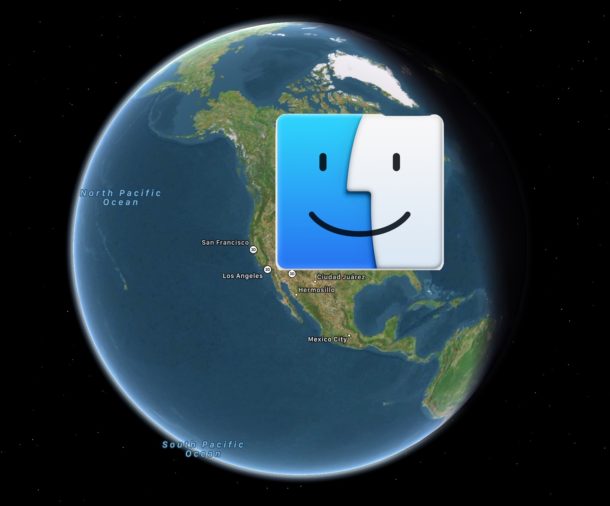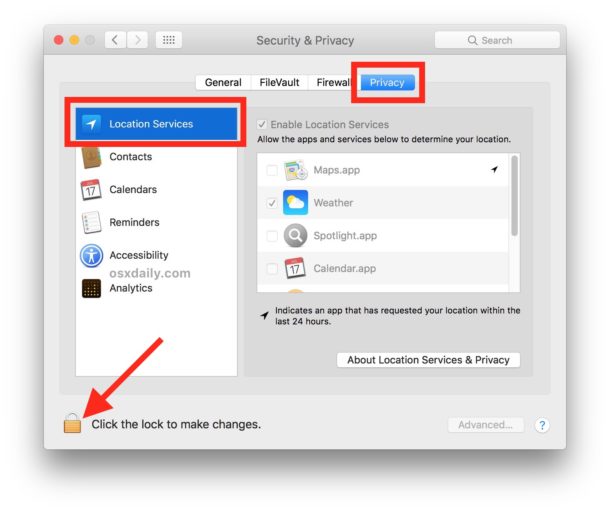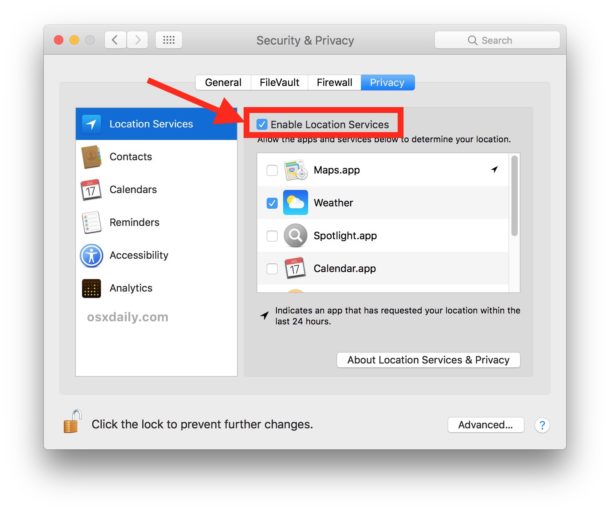How to Disable Location Services on Mac

Some Mac users may wish to completely disable Location Services features on their Mac. This is not recommended for most Mac owners, but turning off all Location Services functionality on MacOS can be desired for security concerns and privacy considerations, or even by systems administrators who don’t want the manage the geolocation features.
Disabling geolocation and location services on the Mac is pretty easy, but do note that by turning off Location Services on a Mac that computer will lose the ability to use important features like Find My Mac, and even simple tasks like using the Maps app or web-based map functionalities to get directions from your current location to elsewhere. Accordingly, most Mac users should probably leave location services enabled, or at least just selectively disable the location features for apps they don’t want to use location data.
How to Disable All Location Services on Mac
Toggling this system setting will disable all geographic location-based functionality on a Mac:
- Go to the Apple menu and choose “System Preferences”
- Choose “Security & Privacy”
- Go to the “Privacy” tab
- Select “Location Services” from the left-side menu
- Click the unlock button in the lower left corner to be able to make changes, then authenticate with an admin login
- Check the box next to “Enable Location Services”
- Confirm that you want to turn off Location Services by choosing “Turn Off” *



With Location Services disabled on the Mac, no Mac apps or services will be able to use the Macs current location.
Disabling Location Services means that you won’t be able to get your current location from things like asking Siri about the weather, or getting directions from Maps, or other such tasks on the Mac.
Note that turning this setting off is not going to strip location data from files or remove location data that is already stored elsewhere, whether in apps or metadata, it simply prevents apps from using or determining your location moving forward. Usually the type of files that may contain location data are pictures, and if you have image files that you want to remove location data from on a Mac, you can remove location from pictures in Photos on Mac one by one, or you can drop all the images into a Mac app like ImageOptim to strip geolocation data and all other metadata from the picture files.
* Perhaps the biggest downside to disabling Location Services on a Mac is that it also simultaneously turns off the very useful “Find My Mac” feature, which is similar to “Find My iPhone” in that it allows you to locate a Mac that is misplaced or stolen.
Completely turning off location functionalities on a Mac may be a little extreme for some users, so for many a better approach might be to selectively controlling location use, and managing or disabling the location services features on a per-app and per system feature or process basis through the same System Preference panel. It can also be helpful to enable the location usage indicator in the Mac menu bar so that it’s easy to determine when and what app is using location data.
If your primary reason for turning off location services is for privacy or security purposes, you might also want to disable Location Services on iPhone and iPad as well, though that can be a bit distract and often just turning off Location Services for apps that don’t need location data, like any social media or the camera, is sufficient.
The tips here apply to modern versions of MacOS (Mojave, High Sierra, Sierra) and Mac OS X (El Capitan, Yosemite, Mavericks, etc) but if you have an older Mac with Snow Leopard, using a different setting you can also disable Location Services if you don’t want location data to be used on the computer.
Of course you can also reverse this decision and enable Location Services on the Mac too:
How to Re-Enable Location Services Features on Mac
If you turned off Location Services and regret doing so, or want to enable it on a Mac otherwise, doing so is just a matter of reversing the above steps so that you enable location functionality again:
- Go to the Apple menu and choose “System Preferences”
- Select the “Security & Privacy” panel and then choose the Privacy tab
- Select “Location Services” from the left-side menu
- Click the unlock button to authenticate with an admin login
- Check the box next to “Enable Location Services” to enable the location features

Most Mac users should keep the Location Services feature enabled, though prudently disabling the location functionality for apps that don’t require location data is still a sound idea.


I have all preference for location and web app activity “paused” but still when I am in France and I open google on my MacbookPro the Google search engine comes up in French. As I don’t understand French its driving me nuts. I have selected Google.co.uk as my primary search engine but the page will open in English and then revert to French and the search results are often restricted to French web sites that I don’t want. How do I change this for ever!!!
Elizabeth, great question. What you are experiencing has nothing to do with location services of the Mac itself, so disabling Mac location services will not resolve the redirect. Instead what you are seeing is because you are located in France, so Google detects your French IP address and is serving the French version of Google to you because you are using a French IP. They do this with all countries and IP addresses.
There are a few options for this situation you find yourself in, which is quite common for travelers and expats:
– Try using http://google.com/ncr which is the No Country Redirect version of Google web search. That option is discussed here:
https://osxdaily.com/2011/11/22/stop-google-com-redirecting/
– You could use a VPN back to UK to show Google an English language (USA, UK, Canada, Australia) or UK IP address. There are many VPN options, and one is available free in the Opera web browser as discussed here:
https://osxdaily.com/2016/04/23/use-free-vpn-opera-browser/
– Use a web browser like Epic and change the proxy IP to the geolocation / language/country you are hoping to use Google for, discussed here:
https://osxdaily.com/2019/01/30/change-ip-address-geolocation-epic-web-browser/
– Another option is to use a different search service, like Bing or DuckDuckGo.
Hope that helps!
Thanks.
While we’re on the topic of privacy, here are some helpful links to remove your personal data from the various websites out there that attempt to aggregate and gather data about you online:
https://www.abine.com/optouts.php
https://tisiphone.net/2017/01/25/thwart-my-osint-efforts-while-binging-tv/
https://inteltechniques.com/blog/
https://inteltechniques.com/blog/2018/07/12/data-removal-workbook-updated/
Just a start!
Please tell me why Apple Maps and Siri cannot determine my location on my iMac unless WiFi is on. I use a wired Ethernet connection and this prevents Siri or Maps from being able to locate me. Ridiculous! Google Maps and weather sites have no problem.
That’s interesting, I haven’t used ethernet on a Mac in a while since it requires yet another dongle…
I know that wi-fi triangulation as a means of location detection is a thing.
Now, you can turn of wi-fi aspect of geolocation hidden in the Location Services settings on the Mac. Scroll down the list and choose “System Services” and you can uncheck it there.
I think this would be more useful if disabling the location settings included the ability to disable ip geolocation, which is used by many websites to disable certain features such as payment methods or access to certain content for people connecting from certain countries. Currently, IP geolocation still works even when GPS or Wifi location tracking is turned off.
Indeed you are right, your IP address is always visible! Now you can try to mask it, but you must ask yourself why and the purpose, because it’s only so effective (and that is to say, not too effective). There are MANY legitimate reasons to do this; read articles in foreign countries, access secures services while traveling, access country-specific services when traveling, testing geographic specific services and products, etc etc. And for those reasons it can be acceptable. Then there are the ‘black hat’ reasons which are shadier and into the realm of the questionable, but that’s another topic.
As far as I know, the only way to try and get around IP Geolocation on the web is to use a VPN or web proxy, or maybe even TOR (though TOR is incredibly problematic for other reasons and it’s so shady it’s best to avoid), or a similar type of hop, to try and mask your geolocation.
But your point is understood, IP address can be very specific and so some services can get your IP address and pinpoint your address to near precision, which is a privacy risk if you do not want the organizations to know your IP address or where it can be traced back to. Many common websites do this for legitimate reasons, like “give us your location so that you can find a store near you” or auto-detecting your location generally so that they can target weather or news to your location, etc.
For a novice purpose, if you simply want to ‘spoof’ a IP geolocation for testing purposes, like for a developer to test an American, European, Asian version of a product or web site for example, a common approach is to use a VPN based in the location you want to test from. Even Opera the web browser offers a simple VPN for that purpose, and it works pretty well. But by no means is anything anonymous.
IP address leakage and attribution is how many ‘hackers’ are caught, it’s basically a perfect match location footprint. Then an ISP can be requested to give data on that IP address to discover the person, billing account, etc behind that IP address. Even things like a VPN or TOR are not perfect to protect the leaking of an IP address. I read a fair amount about this stuff because I find it interesting, for example that is why a lot of ‘malware’ runs on computers, so that someone else can try to connect to a computer and then bounce off a different IP address… but of course that connection to the malware leaves an IP footprint as well… so it’s just a matter of following IP address connections up or down the chain. That’s basically what TOR tries to do by the way, minus the malware anyway, but just pass an IP address around to obfuscate the originator, rather imperfectly.
The reality is, if you’re online, you’re not anonymous or private. There is always a way to track you down if someone is committed enough. That’s the world we live in today of globally connected internet-of-things!